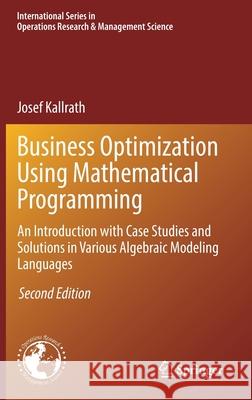Business Optimization Using Mathematical Programming: An Introduction with Case Studies and Solutions in Various Algebraic Modeling Languages » książka
topmenu
Business Optimization Using Mathematical Programming: An Introduction with Case Studies and Solutions in Various Algebraic Modeling Languages
ISBN-13: 9783030732363 / Angielski / Twarda / 2021 / 633 str.
Business Optimization Using Mathematical Programming: An Introduction with Case Studies and Solutions in Various Algebraic Modeling Languages
ISBN-13: 9783030732363 / Angielski / Twarda / 2021 / 633 str.
cena 562,23
(netto: 535,46 VAT: 5%)
Najniższa cena z 30 dni: 539,74
(netto: 535,46 VAT: 5%)
Najniższa cena z 30 dni: 539,74
Termin realizacji zamówienia:
ok. 22 dni roboczych.
ok. 22 dni roboczych.
Darmowa dostawa!
Kategorie:
Kategorie BISAC:
Wydawca:
Springer
Seria wydawnicza:
Język:
Angielski
ISBN-13:
9783030732363
Rok wydania:
2021
Wydanie:
2021
Numer serii:
000904291
Ilość stron:
633
Waga:
1.09 kg
Wymiary:
23.39 x 15.6 x 3.66
Oprawa:
Twarda
Wolumenów:
01
Dodatkowe informacje:
Wydanie ilustrowane











